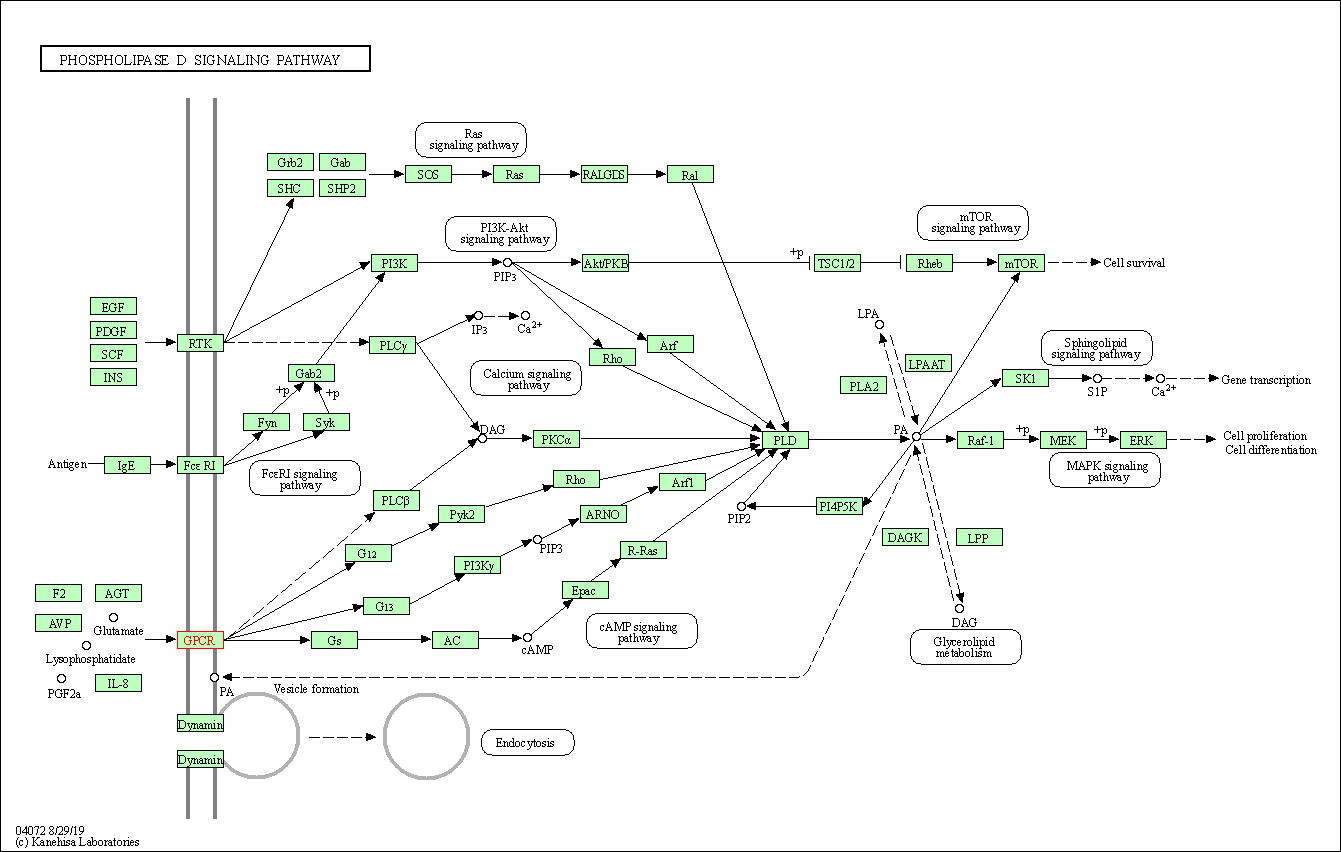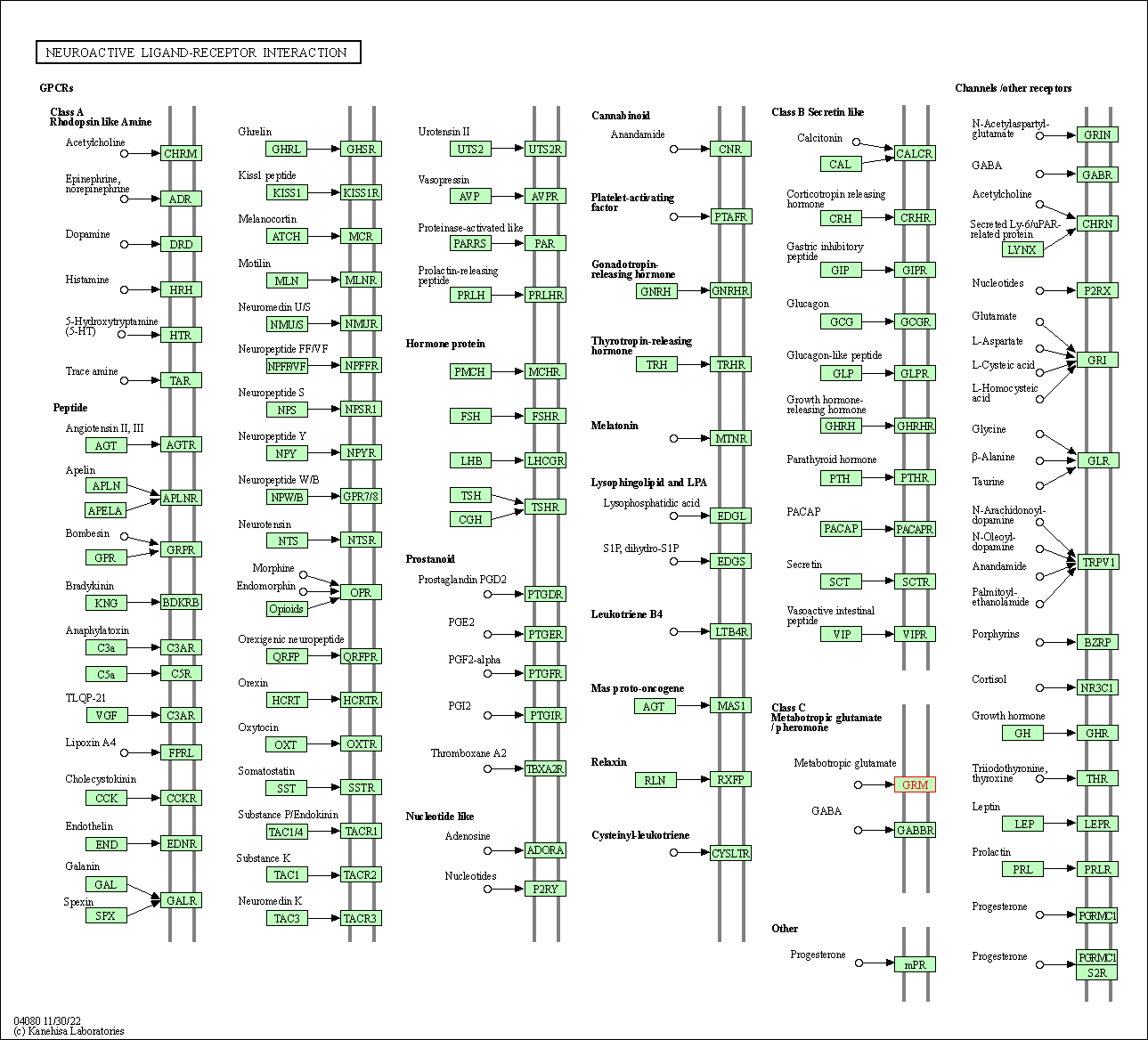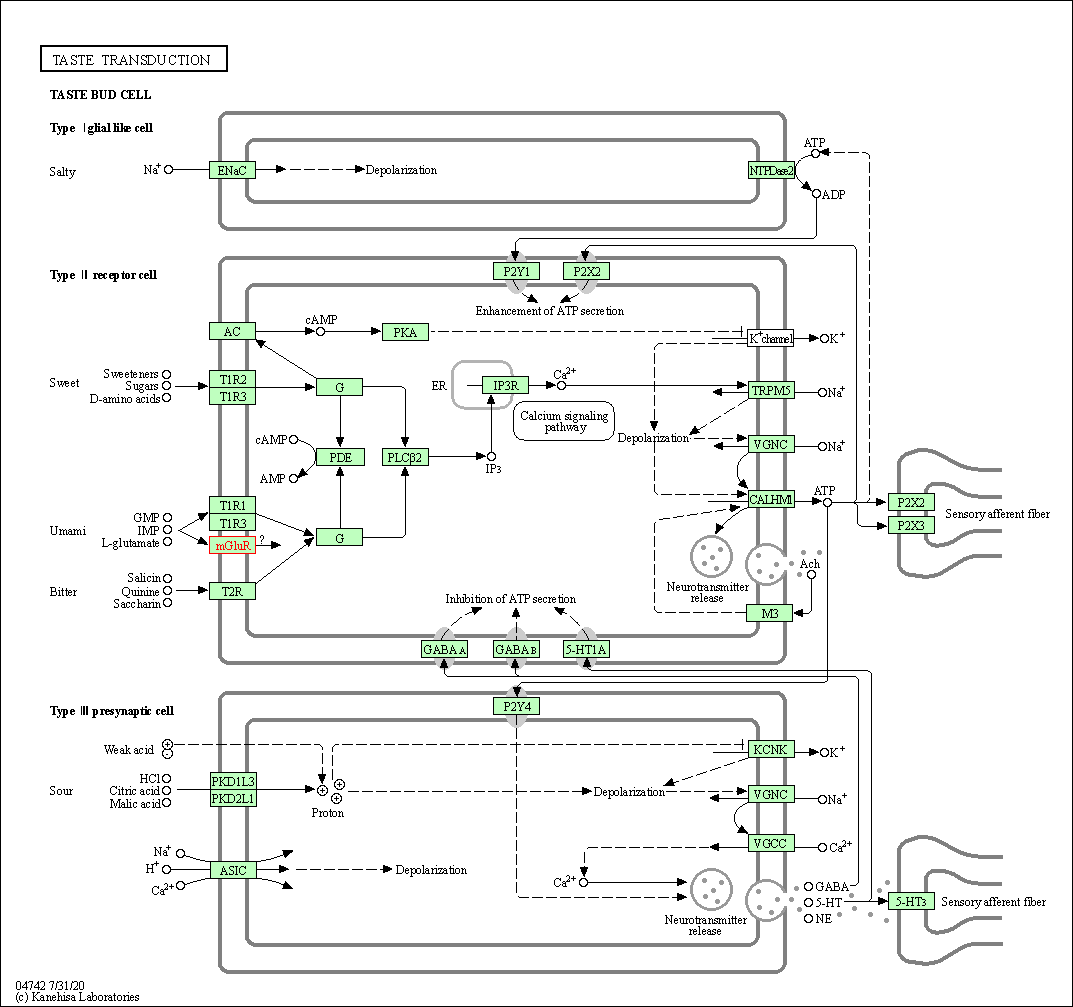Target Information
| Target General Information | Top | |||||
|---|---|---|---|---|---|---|
| Target ID |
T99402
(Former ID: TTDR00965)
|
|||||
| Target Name |
Metabotropic glutamate receptor 4 (mGluR4)
|
|||||
| Synonyms |
mGluR4; Group III metabotropic glutamate receptor 4; GPRC1D
Click to Show/Hide
|
|||||
| Gene Name |
GRM4
|
|||||
| Target Type |
Literature-reported target
|
[1] | ||||
| Disease | [+] 1 Target-related Diseases | + | ||||
| 1 | Parkinsonism [ICD-11: 8A00] | |||||
| Function |
Ligand binding causes a conformation change that triggers signaling via guanine nucleotide-binding proteins (G proteins) and modulates the activity of down-stream effectors. Signaling inhibits adenylate cyclase activity. G-protein coupled receptor for glutamate.
Click to Show/Hide
|
|||||
| BioChemical Class |
GPCR glutamate
|
|||||
| UniProt ID | ||||||
| Sequence |
MPGKRGLGWWWARLPLCLLLSLYGPWMPSSLGKPKGHPHMNSIRIDGDITLGGLFPVHGR
GSEGKPCGELKKEKGIHRLEAMLFALDRINNDPDLLPNITLGARILDTCSRDTHALEQSL TFVQALIEKDGTEVRCGSGGPPIITKPERVVGVIGASGSSVSIMVANILRLFKIPQISYA STAPDLSDNSRYDFFSRVVPSDTYQAQAMVDIVRALKWNYVSTVASEGSYGESGVEAFIQ KSREDGGVCIAQSVKIPREPKAGEFDKIIRRLLETSNARAVIIFANEDDIRRVLEAARRA NQTGHFFWMGSDSWGSKIAPVLHLEEVAEGAVTILPKRMSVRGFDRYFSSRTLDNNRRNI WFAEFWEDNFHCKLSRHALKKGSHVKKCTNRERIGQDSAYEQEGKVQFVIDAVYAMGHAL HAMHRDLCPGRVGLCPRMDPVDGTQLLKYIRNVNFSGIAGNPVTFNENGDAPGRYDIYQY QLRNDSAEYKVIGSWTDHLHLRIERMHWPGSGQQLPRSICSLPCQPGERKKTVKGMPCCW HCEPCTGYQYQVDRYTCKTCPYDMRPTENRTGCRPIPIIKLEWGSPWAVLPLFLAVVGIA ATLFVVITFVRYNDTPIVKASGRELSYVLLAGIFLCYATTFLMIAEPDLGTCSLRRIFLG LGMSISYAALLTKTNRIYRIFEQGKRSVSAPRFISPASQLAITFSLISLQLLGICVWFVV DPSHSVVDFQDQRTLDPRFARGVLKCDISDLSLICLLGYSMLLMVTCTVYAIKTRGVPET FNEAKPIGFTMYTTCIVWLAFIPIFFGTSQSADKLYIQTTTLTVSVSLSASVSLGMLYMP KVYIILFHPEQNVPKRKRSLKAVVTAATMSNKFTQKGNFRPNGEAKSELCENLEAPALAT KQTYVTYTNHAI Click to Show/Hide
|
|||||
| 3D Structure | Click to Show 3D Structure of This Target | AlphaFold | ||||
| Drugs and Modes of Action | Top | |||||
|---|---|---|---|---|---|---|
| Clinical Trial Drug(s) | [+] 1 Clinical Trial Drugs | + | ||||
| 1 | DT-1687 | Drug Info | Phase 2 | Parkinson disease | [2] | |
| Mode of Action | [+] 5 Modes of Action | + | ||||
| Modulator | [+] 2 Modulator drugs | + | ||||
| 1 | DT-1687 | Drug Info | [1] | |||
| 2 | ADX-88178 | Drug Info | [1] | |||
| Inhibitor | [+] 1 Inhibitor drugs | + | ||||
| 1 | (2S,1'R,2'S)-2-(2'-phosphonocyclopropyl)glycine | Drug Info | [3] | |||
| Agonist | [+] 8 Agonist drugs | + | ||||
| 1 | (S)-3,4-DCPG | Drug Info | [4] | |||
| 2 | ACPT-I | Drug Info | [6] | |||
| 3 | FP0429 | Drug Info | [8] | |||
| 4 | L-AP4 | Drug Info | [3], [7] | |||
| 5 | L-CCG-I | Drug Info | [9] | |||
| 6 | L-serine-O-phosphate | Drug Info | [10] | |||
| 7 | LSP1-2111 | Drug Info | [11] | |||
| 8 | LSP4-2022 | Drug Info | [12] | |||
| Modulator (allosteric modulator) | [+] 14 Modulator (allosteric modulator) drugs | + | ||||
| 1 | 2-methyl-6-(phenylethynyl)pyridine | Drug Info | [5] | |||
| 2 | Lu AF21934 | Drug Info | [13] | |||
| 3 | PHCCC | Drug Info | [14] | |||
| 4 | PMID20638279C11 | Drug Info | [15] | |||
| 5 | PMID20638279C7 | Drug Info | [15] | |||
| 6 | PMID21688779C22a | Drug Info | [16] | |||
| 7 | PMID22465637C1 | Drug Info | [17] | |||
| 8 | VU0001171 | Drug Info | [18] | |||
| 9 | VU0092145 | Drug Info | [18] | |||
| 10 | VU0155041 | Drug Info | [19] | |||
| 11 | VU0359516 | Drug Info | [20] | |||
| 12 | VU0361737 | Drug Info | [21] | |||
| 13 | VU0364770 | Drug Info | [22] | |||
| 14 | VU0400195 | Drug Info | [23] | |||
| Antagonist | [+] 3 Antagonist drugs | + | ||||
| 1 | CPPG | Drug Info | [7] | |||
| 2 | MAP4 | Drug Info | [7] | |||
| 3 | MPPG | Drug Info | [7] | |||
| Cell-based Target Expression Variations | Top | |||||
|---|---|---|---|---|---|---|
| Cell-based Target Expression Variations | ||||||
| Drug Binding Sites of Target | Top | |||||
|---|---|---|---|---|---|---|
| Ligand Name: L-serine-O-phosphate | Ligand Info | |||||
| Structure Description | Cryo-EM structure of Gi-bound metabotropic glutamate receptor mGlu4 | PDB:7E9H | ||||
| Method | Electron microscopy | Resolution | 4.00 Å | Mutation | Yes | [24] |
| PDB Sequence |
NSIRIDGDIT
50 LGGLFPVHGR60 GSEGKPCGEL70 KKEKGIHRLE80 AMLFALDRIN90 NDPDLLPNIT 100 LGARILDTCS110 RDTHALEQSL120 TFVQALIERV150 VGVIGASGSS160 VSIMVANILR 170 LFKIPQISYA180 STAPDLSDNS190 RYDFFSRVVP200 SDTYQAQAMV210 DIVRALKWNY 220 VSTVASEGSY230 GESGVEAFIQ240 KSREDGGVCI250 AQSVKIPREP260 KAGEFDKIIR 270 RLLETSNARA280 VIIFANEDDI290 RRVLEAARRA300 NQTGHFFWMG310 SDSWGSKIAP 320 VLHLEEVAEG330 AVTILPKRMS340 VRGFDRYFSS350 RTLDNNRRNI360 WFAEFWEDNF 370 HCKLVKKCTN390 RERIGQDSAY400 EQEGKVQFVI410 DAVYAMGHAL420 HAMHRDLCPG 430 RVGLCPRMDP440 VDGTQLLKYI450 RNVNFSGIAG460 NPVTFNENGD470 APGRYDIYQY 480 QLRAEYKVIG493 SWTDHLHLRI503 QQLPRSICSL522 PCQPGERKKT532 VKGMPCCWHC 542 EPCTGYQYQV552 DRYTCKTCPY562 DMRPTENRTG572 CRPIPIIKLE582 WGSPWAVLPL 592 FLAVVGIAAT602 LFVVITFVRY612 NDTPIVKASG622 RELSYVLLAG632 IFLCYATTFL 642 MIAEPDLGTC652 SLRRIFLGLG662 MSISYAALLT672 KTNRIYRIFE682 QGKRSVSAPR 692 FISPASQLAI702 TFSLISLQLL712 GICVWFVVDP722 SHSVVDFQDQ732 RTLDPRFARG 742 VLKCDISDLS752 LICLLGYSML762 LMVTCTVYAI772 KTRGVPETFN782 EAKPIGFTMY 792 TTCIVWLAFI802 PIFFGTSQSA812 DKLYIQTTTL822 TVSVSLSASV832 SLGMLYMPKV 842 YIILFH
|
|||||
|
|
||||||
| Click to View More Binding Site Information of This Target with Different Ligands | ||||||
| Different Human System Profiles of Target | Top |
|---|---|
|
Human Similarity Proteins
of target is determined by comparing the sequence similarity of all human proteins with the target based on BLAST. The similarity proteins for a target are defined as the proteins with E-value < 0.005 and outside the protein families of the target.
A target that has fewer human similarity proteins outside its family is commonly regarded to possess a greater capacity to avoid undesired interactions and thus increase the possibility of finding successful drugs
(Brief Bioinform, 21: 649-662, 2020).
Human Tissue Distribution
of target is determined from a proteomics study that quantified more than 12,000 genes across 32 normal human tissues. Tissue Specificity (TS) score was used to define the enrichment of target across tissues.
The distribution of targets among different tissues or organs need to be taken into consideration when assessing the target druggability, as it is generally accepted that the wider the target distribution, the greater the concern over potential adverse effects
(Nat Rev Drug Discov, 20: 64-81, 2021).
Human Pathway Affiliation
of target is determined by the life-essential pathways provided on KEGG database. The target-affiliated pathways were defined based on the following two criteria (a) the pathways of the studied target should be life-essential for both healthy individuals and patients, and (b) the studied target should occupy an upstream position in the pathways and therefore had the ability to regulate biological function.
Targets involved in a fewer pathways have greater likelihood to be successfully developed, while those associated with more human pathways increase the chance of undesirable interferences with other human processes
(Pharmacol Rev, 58: 259-279, 2006).
Human Similarity Proteins
Human Tissue Distribution
Human Pathway Affiliation
|
|
|
There is no similarity protein (E value < 0.005) for this target
|
|
Note:
If a protein has TS (tissue specficity) scores at least in one tissue >= 2.5, this protein is called tissue-enriched (including tissue-enriched-but-not-specific and tissue-specific). In the plots, the vertical lines are at thresholds 2.5 and 4.
|




| KEGG Pathway | Pathway ID | Affiliated Target | Pathway Map |
|---|---|---|---|
| Phospholipase D signaling pathway | hsa04072 | Affiliated Target |

|
| Class: Environmental Information Processing => Signal transduction | Pathway Hierarchy | ||
| Neuroactive ligand-receptor interaction | hsa04080 | Affiliated Target |

|
| Class: Environmental Information Processing => Signaling molecules and interaction | Pathway Hierarchy | ||
| Glutamatergic synapse | hsa04724 | Affiliated Target |

|
| Class: Organismal Systems => Nervous system | Pathway Hierarchy | ||
| Taste transduction | hsa04742 | Affiliated Target |

|
| Class: Organismal Systems => Sensory system | Pathway Hierarchy | ||
| Chemical Structure based Activity Landscape of Target | Top |
|---|---|
| Drug Property Profile of Target | Top | |
|---|---|---|
| (1) Molecular Weight (mw) based Drug Clustering | (2) Octanol/Water Partition Coefficient (xlogp) based Drug Clustering | |
|
|
||
| (3) Hydrogen Bond Donor Count (hbonddonor) based Drug Clustering | (4) Hydrogen Bond Acceptor Count (hbondacc) based Drug Clustering | |
|
|
||
| (5) Rotatable Bond Count (rotbonds) based Drug Clustering | (6) Topological Polar Surface Area (polararea) based Drug Clustering | |
|
|
||
| "RO5" indicates the cutoff set by lipinski's rule of five; "D123AB" colored in GREEN denotes the no violation of any cutoff in lipinski's rule of five; "D123AB" colored in PURPLE refers to the violation of only one cutoff in lipinski's rule of five; "D123AB" colored in BLACK represents the violation of more than one cutoffs in lipinski's rule of five | ||
| Target Poor or Non Binders | Top | |||||
|---|---|---|---|---|---|---|
| Target Poor or Non Binders | ||||||
| Target Regulators | Top | |||||
|---|---|---|---|---|---|---|
| Target-regulating microRNAs | ||||||
| Target Affiliated Biological Pathways | Top | |||||
|---|---|---|---|---|---|---|
| KEGG Pathway | [+] 3 KEGG Pathways | + | ||||
| 1 | Neuroactive ligand-receptor interaction | |||||
| 2 | Glutamatergic synapse | |||||
| 3 | Taste transduction | |||||
| Panther Pathway | [+] 3 Panther Pathways | + | ||||
| 1 | Heterotrimeric G-protein signaling pathway-Gi alpha and Gs alpha mediated pathway | |||||
| 2 | Heterotrimeric G-protein signaling pathway-Gq alpha and Go alpha mediated pathway | |||||
| 3 | Metabotropic glutamate receptor group III pathway | |||||
| Reactome | [+] 2 Reactome Pathways | + | ||||
| 1 | G alpha (i) signalling events | |||||
| 2 | Class C/3 (Metabotropic glutamate/pheromone receptors) | |||||
| WikiPathways | [+] 3 WikiPathways | + | ||||
| 1 | GPCRs, Class C Metabotropic glutamate, pheromone | |||||
| 2 | GPCR ligand binding | |||||
| 3 | GPCR downstream signaling | |||||
| Target-Related Models and Studies | Top | |||||
|---|---|---|---|---|---|---|
| Target Validation | ||||||
| References | Top | |||||
|---|---|---|---|---|---|---|
| REF 1 | URL: http://www.guidetopharmacology.org Nucleic Acids Res. 2015 Oct 12. pii: gkv1037. The IUPHAR/BPS Guide to PHARMACOLOGY in 2016: towards curated quantitative interactions between 1300 protein targets and 6000 ligands. (Target id: 292). | |||||
| REF 2 | Clinical pipeline report, company report or official report of the Pharmaceutical Research and Manufacturers of America (PhRMA) | |||||
| REF 3 | Synthesis and preliminary pharmacological evaluation of the four stereoisomers of (2S)-2-(2'-phosphono-3'-phenylcyclopropyl)glycine, the first clas... Bioorg Med Chem. 2007 May 1;15(9):3161-70. | |||||
| REF 4 | (S)-3,4-DCPG, a potent and selective mGlu8a receptor agonist, activates metabotropic glutamate receptors on primary afferent terminals in the neonatal rat spinal cord. Neuropharmacology. 2001 Mar;40(3):311-8. | |||||
| REF 5 | Positive allosteric modulation of the human metabotropic glutamate receptor 4 (hmGluR4) by SIB-1893 and MPEP. Br J Pharmacol. 2003 Mar;138(6):1026-30. | |||||
| REF 6 | Synthesis and pharmacological characterization of aminocyclopentanetricarboxylic acids: new tools to discriminate between metabotropic glutamate receptor subtypes. J Med Chem. 1997 Sep 12;40(19):3119-29. | |||||
| REF 7 | Ligand binding to the amino-terminal domain of the mGluR4 subtype of metabotropic glutamate receptor. J Biol Chem. 1999 Apr 9;274(15):10008-13. | |||||
| REF 8 | Amino-pyrrolidine tricarboxylic acids give new insight into group III metabotropic glutamate receptor activation mechanism. Mol Pharmacol. 2007 Mar;71(3):704-12. | |||||
| REF 9 | Agonist analysis of 2-(carboxycyclopropyl)glycine isomers for cloned metabotropic glutamate receptor subtypes expressed in Chinese hamster ovary cells. Br J Pharmacol. 1992 Oct;107(2):539-43. | |||||
| REF 10 | Serine-O-phosphate has affinity for type IV, but not type I, metabotropic glutamate receptor. Neuroreport. 1993 Sep;4(9):1099-101. | |||||
| REF 11 | Electrophysiological and behavioral evidence that modulation of metabotropic glutamate receptor 4 with a new agonist reverses experimental parkinsonism. FASEB J. 2009 Oct;23(10):3619-28. | |||||
| REF 12 | A novel selective metabotropic glutamate receptor 4 agonist reveals new possibilities for developing subtype selective ligands with therapeutic potential. FASEB J. 2012 Apr;26(4):1682-93. | |||||
| REF 13 | Synergy between L-DOPA and a novel positive allosteric modulator of metabotropic glutamate receptor 4: implications for Parkinson's disease treatment and dyskinesia. Neuropharmacology. 2013 Mar;66:158-69. | |||||
| REF 14 | (-)-PHCCC, a positive allosteric modulator of mGluR4: characterization, mechanism of action, and neuroprotection. Neuropharmacology. 2003 Dec;45(7):895-906. | |||||
| REF 15 | An orally bioavailable positive allosteric modulator of the mGlu4 receptor with efficacy in an animal model of motor dysfunction. Bioorg Med Chem Lett. 2010 Aug 15;20(16):4901-5. | |||||
| REF 16 | Tricyclic thiazolopyrazole derivatives as metabotropic glutamate receptor 4 positive allosteric modulators. J Med Chem. 2011 Jul 28;54(14):5070-81. | |||||
| REF 17 | 4-(1-Phenyl-1H-pyrazol-4-yl)quinolines as novel, selective and brain penetrant metabotropic glutamate receptor 4 positive allosteric modulators. Bioorg Med Chem Lett. 2012 May 1;22(9):3235-9. | |||||
| REF 18 | Positive allosteric modulators of the metabotropic glutamate receptor subtype 4 (mGluR4). Part II: Challenges in hit-to-lead. Bioorg Med Chem Lett. 2009 Feb 1;19(3):962-6. | |||||
| REF 19 | Discovery, characterization, and antiparkinsonian effect of novel positive allosteric modulators of metabotropic glutamate receptor 4. Mol Pharmacol. 2008 Nov;74(5):1345-58. | |||||
| REF 20 | Re-exploration of the PHCCC Scaffold: Discovery of Improved Positive Allosteric Modulators of mGluR4. ACS Chem Neurosci. 2010 Jun 16;1(6):411-419. | |||||
| REF 21 | Synthesis and evaluation of a series of heterobiarylamides that are centrally penetrant metabotropic glutamate receptor 4 (mGluR4) positive allosteric modulators (PAMs). J Med Chem. 2009 Jul 23;52(14):4115-8. | |||||
| REF 22 | The metabotropic glutamate receptor 4-positive allosteric modulator VU0364770 produces efficacy alone and in combination with L-DOPA or an adenosine 2A antagonist in preclinical rodent models of Parkinson's disease. J Pharmacol Exp Ther. 2012 Feb;340(2):404-21. | |||||
| REF 23 | Discovery, synthesis, and structure-activity relationship development of a series of N-4-(2,5-dioxopyrrolidin-1-yl)phenylpicolinamides (VU0400195, ML182): characterization of a novel positive allosteric modulator of the metabotropic glutamate receptor 4 (mGlu(4)) with oral efficacy in an antiparkinsonian animal model. J Med Chem. 2011 Nov 10;54(21):7639-47. | |||||
| REF 24 | Structures of G(i)-bound metabotropic glutamate receptors mGlu2 and mGlu4. Nature. 2021 Jun;594(7864):583-588. | |||||
If You Find Any Error in Data or Bug in Web Service, Please Kindly Report It to Dr. Zhou and Dr. Zhang.

